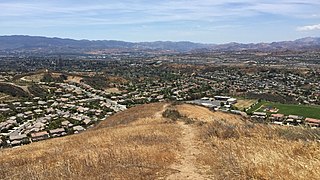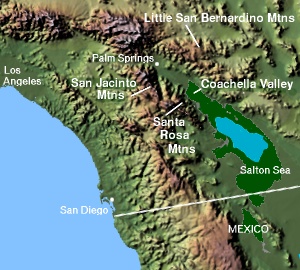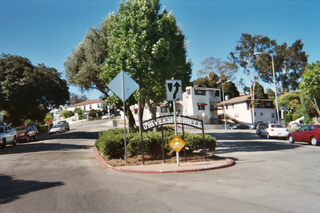Coordinates: 34°14′38″N118°53′48″W / 34.2438889°N 118.8966667°W The Santa Rosa Valley is a small valley and rural unincorporated community in Ventura County, Southern California. [1]

A geographic coordinate system is a coordinate system that enables every location on Earth to be specified by a set of numbers, letters or symbols. The coordinates are often chosen such that one of the numbers represents a vertical position and two or three of the numbers represent a horizontal position; alternatively, a geographic position may be expressed in a combined three-dimensional Cartesian vector. A common choice of coordinates is latitude, longitude and elevation. To specify a location on a plane requires a map projection.

A valley is a low area between hills or mountains typically with a river running through it. In geology, a valley or dale is a depression that is longer than it is wide. The terms U-shaped and V-shaped are descriptive terms of geography to characterize the form of valleys. Most valleys belong to one of these two main types or a mixture of them, at least with respect to the cross section of the slopes or hillsides.

In law, an unincorporated area is a region of land that is not governed by a local municipal corporation; similarly an unincorporated community is a settlement that is not governed by its own local municipal corporation, but rather is administered as part of larger administrative divisions, such as a township, parish, borough, county, city, canton, state, province or country. Occasionally, municipalities dissolve or disincorporate, which may happen if they become fiscally insolvent, and services become the responsibility of a higher administration. Widespread unincorporated communities and areas are a distinguishing feature of the United States and Canada. In most other countries of the world, there are either no unincorporated areas at all, or these are very rare; typically remote, outlying, sparsely populated or uninhabited areas.
The valley is about 5 miles (8.0 km) long (east to west) and 2 miles (3.2 km) wide (north to south).
Although not within its city limits, the community is sometimes considered to be an outlying neighborhood of Camarillo.

Camarillo is a city in Ventura County in the U.S. state of California. The population was 65,201 at the 2010 census, up from 57,084 at the 2000 census. The Ventura Freeway is the city's primary thoroughfare. Camarillo is named for Adolfo and Juan Camarillo, two of the few Californios to preserve the city's heritage after the arrival of Anglo settlers. The railroad coast route came through in 1898 and built a station here. Adolfo Camarillo eventually employed 700 workers growing mainly lima beans. Walnuts and citrus were also grown on the ranch. Adolfo bred Camarillo White Horses in the 1920s through the 1960s and was well known for riding them, dressed in colorful Spanish attire, in parades such as the Fiesta of Santa Barbara.
There is an elementary school within the valley, Santa Rosa Technology Magnet School, which is part of the PVSD district.
It is bordered on the south by the western Simi Hills and Wildwood Regional Park, and on the north by Las Posas Hills. The valley is drained principally by the Arroyo Santa Rosa, a tributary of Calleguas Creek which flows into the Pacific Ocean at Mugu Lagoon.

The Simi Hills are a low rocky mountain range of the Transverse Ranges in eastern Ventura County and western Los Angeles County, of southern California, United States.

Wildwood Regional Park is a suburban regional park in the western Simi Hills and Conejo Valley, in Ventura County, California. It is located in western Thousand Oaks, northern Newbury Park, and southern Moorpark.
Calleguas Creek is the terminus of a river system in Ventura County, California. It drains the Calleguas Creek Watershed, an area 30 miles long and 14 miles wide, which includes Simi Valley, Moorpark, Camarillo and a large portion of Thousand Oaks. Tributaries include Arroyo Simi, Arroyo Santa Rosa, Revolon Slough and Arroyo Conejo. It discharges into the Pacific Ocean, the Santa Barbara Channel, at Mugu Lagoon on Naval Base Ventura County, just north of Point Mugu, where the Santa Monica Mountains meet the ocean, marking the southern/eastern boundary of the Oxnard Plain.
















